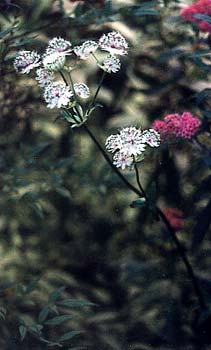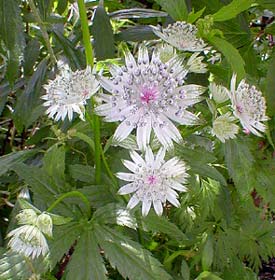
Masterwort:
a lovely Euopean wildflower
"Life is an old man carrying flowers on his head."
-e. e. cummings
(1894-1962)
(1894-1962)
Masterwort (Astrantia major) grows wild in Switzerland. It is an interesting clumping perennial for a woodland setting, shown at top in a July 2002 portrait, & a blossom close up below in a June 2003 portrait. In the first photo, visible behind the masterwort, are the pink flowers of a Japanese Spirea, & to the left can be seen some of the leaves of Nandina domestica.
Masterwort has a relatively low-growing bushy rosette of leaves from which spring tummy-high to head-high stems with one-inch pink-tipped white pincushion or dustmop flowers.
There are cultivars with different color blossoms, but even our natural variety is awfully showy & pleasing. Besides the white wild form of masterwort shown on this page, we also have a named cultivar that is rather pinker, called Lars' Masterwort which is a bit smaller & slower in its growth.
 The name Astrantia, as with Asters, alludes to the blooms' star-like presentation. Compared to one decade ago or less, when Masterworts seemed all but absent in American gardens, it is becoming increasingly favored. It is even now more popular in it native Europe than in America, but really should be more utilized here, being one of the flowerier perennials to do well in a considerable portion of shade. Ours is partially shaded by a big bushy Dawn Viburnum as well as by the Nandina & Spirea, out of which array it blooms all summer & well into autumn.
The name Astrantia, as with Asters, alludes to the blooms' star-like presentation. Compared to one decade ago or less, when Masterworts seemed all but absent in American gardens, it is becoming increasingly favored. It is even now more popular in it native Europe than in America, but really should be more utilized here, being one of the flowerier perennials to do well in a considerable portion of shade. Ours is partially shaded by a big bushy Dawn Viburnum as well as by the Nandina & Spirea, out of which array it blooms all summer & well into autumn.It was earliest described as a garden plant in John Gerard's 1597 Herball, & was thereafter subject to disagreements regarding its merits. Reverand William Hansbury in 1770's Complete Handbook of Planting & Gardening dissmised it as "of no great beauty" recommending it be placed in the least important area of a garden; but in 1805's Exotic Botany by James Edward Smith it was more accurately assessed as "a favorite of the more refined admirers of Nature."
Cut flowers last a long while in bouquets & are easily dried for winter reminders of summer gardens. It wants moist well-drained soil & though it can adapt to a little more sun than it prefers, it cannot abide drought. Bees & butterflies are very fond of the blooms.
Deadheading assists rebloom, but if its last flowers of the season are left to go to seed, the dried flowerstalks persist up to the start of winter with a moderate decorativeness of their own.